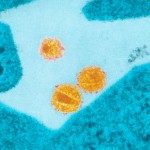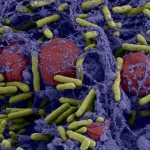Lien vers Pubmed [PMID] – 12609975
J. Biol. Chem. 2003 May;278(22):20358-66
The hepatitis C virus (HCV) genome codes for highly mannosylated envelope proteins, which are naturally retained in the endoplasmic reticulum. We found that the HCV envelope glycoprotein E2 binds the dendritic cell-specific intercellular adhesion molecule 3-grabbing nonintegrin (DC-SIGN) and the related liver endothelial cell lectin L-SIGN through high-mannose N-glycans. Competing ligands such as mannan and an antibody directed against the carbohydrate recognition domains (CRD) abrogated binding. While no E2 interaction with distant monomeric CRDs on biosensor chips could be detected, binding is observed if CRDs are closely seeded (Kd = 48 nm) and if the CRD is part of the oligomeric-soluble extracellular domain of DC-SIGN (Kd = 30 nm). The highest affinity is seen for plasma membrane-expressed DC-SIGN and L-SIGN (Kd = 3 and 6 nm, respectively). These results indicate that several high-mannose N-glycans in a structurally defined cluster on E2 bind to several subunits of the oligomeric lectin CRD. High affinity interaction of viral glycoproteins with oligomeric lectins might represent a strategy by which HCV targets to and concentrates in the liver and infects dendritic cells.


